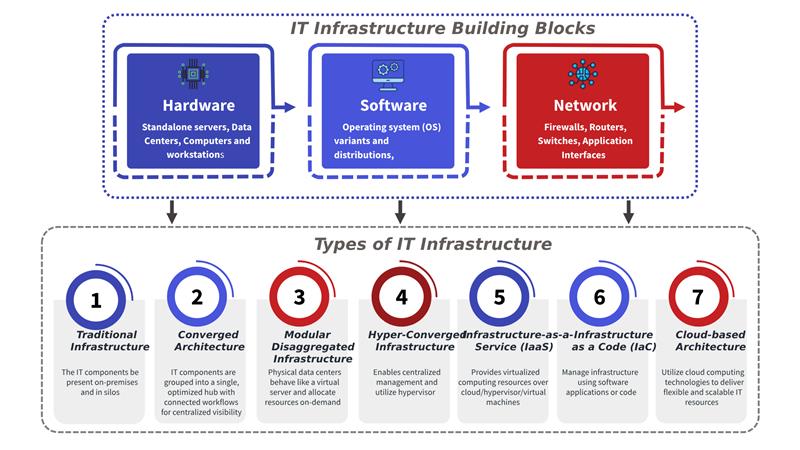IT infrastructure is the invisible foundation of modern digital enterprises. From servers and storage networks to cloud platforms, keeping everything efficient and reliable has become increasingly challenging and more complex than ever. Moreover, with hybrid and multi-cloud environments growing rapidly, traditional tools and processes are already at their limits. Enter Generative AI in IT operations, an innovative solution that helps IT teams automate routine work, detect problems faster, and make better decisions across AI-powered infrastructure management.
IDC forecasts that the worldwide infrastructure market (server and storage) for all kinds of AI is expected to reach $632 billion over the forecast period 2024-2028. The spike in these numbers indeed show the potential of Gen AI in IT infrastructure management has in the IT infrastructure space. So, stay with us to get a 360-degree understanding of several aspects related to AI infrastructure solutions.
Before we head into how Gen AI is transforming the IT infrastructure, let’s review a few basics on IT infrastructure components and the types of IT infrastructures. The three pillars of IT Infrastructure that work to run any organization constitute three building blocks as shown in the image.

Here’s a closer look at how Gen AI is transforming the core areas of AI-powered infrastructure management, Storage Management, Network Operations, and Compute Management.
Gen AI is transforming the Operations Workflow
- Incident Response Gets an Upgrade
When a problem arises, engineers often must search through a mountain of log files, dashboards, and monitoring tools to understand what went wrong. This process is time-consuming and worse at times, inconclusive. Gen AI can transform the tedious process; it can now scan logs, interpret error patterns, and summarize probable root causes within minutes. Instead of spending hours on diagnostics, teams can move straight to remediation. AI-based incident response even suggests fixes based on historical resolutions, freeing engineers from low-level triage.
Learn how the software development industry is undergoing a transformative shift with the advent of Generative AI in software development.
- Unlocking Tribal Knowledge
Many infrastructure teams rely on internal documentation, old Slack threads, or a handful of experienced team members to solve day-to-day problems. Gen AI turns this scattered knowledge into something usable. By training models on your infrastructure documents, runbooks, and configs, you can create internal assistants that answer questions in plain language. Whether it’s “How do I add a new node to a Kubernetes cluster?” or “What ports should be open for this service?”, Gen AI offers contextual answers pulled from your environment. This is where retrieval-augmented generation (RAG) in IT plays a critical role.
- Predicting Failures Before They Happen
While system failures are costly, they often display signs of trouble early on. This could be in the form of CPU spikes, disk read errors, or network latency. Gen AI models can now learn from these signals and predict potential failures before they escalate. This isn’t science fiction. Trained in historical telemetry data, these systems can alert engineers about probable issues with time to intervene. The best part is that these aren’t just vague warnings. Predictive maintenance using Gen AI can explain why it believes a failure may happen and which component is most likely involved.
Read our latest blog post on Top Generative AI Use Cases in Customer Service Across Industries
- Smarter Capacity Planning
Traditional forecasting infrastructure needs used to be about gut feelings and static reports. Today, Gen AI brings intelligence to planning. By analyzing past usage trends, business growth projections, and even external events like product launches or seasonality, Gen AI can produce draft capacity reports. Engineers need only to refine these reports and save hours of manual work. These forecasts also help reduce overprovisioning while at the same time ensuring critical workloads are supported by an adequate number of resources. This marks a shift toward AI for capacity planning.
- Better Control Over Configuration Drift
Drift happens when changes sneak into systems without being reflected in infrastructure-as-a code templates. Over time, this introduces risk, misalignment, and outages. AI-powered configuration management tools can now compare current system states against approved configurations and flag mismatches. Some tools even suggest updates or pull requests to sync everything back up. Rather than manually inspect environments, engineers can review Gen AI generated drifts and take action quickly.
Modern engineering teams rely heavily on chat platforms. But with constant alerts and requests, things can get overwhelming pretty fast and important information can be missed altogether. Gen AI can be embedded in these channels to act as an assistant. It can monitor incoming alerts, classify them by severity, and suggest who should respond. In some cases, it can even draft a reply or open a ticket in the right system. This helps bring in efficiency and structure to what’s often a messy flow of communication. This practical use of Gen AI aligns well with AI infrastructure solutions.
How Can Calsoft Help?
Calsoft has 26+ years of tech expertise and was an early Gen AI adopter. We help businesses adapt fast and deliver better experiences by blending legacy with innovation. Our Gen AI services cover product development, UX design, testing, and integrations. With deep model know-how, our team customizes Gen AI tools to fit your exact needs, offering a complete, practical approach.
We developed an AI code generator using GPT-3 and GPT-4 that was a game-changer for our CSP customer. Investing in this AI code generation tool helps your innovation team do more, without overspending.
AI Code Generation to Accelerate Product Design
If you’d like to explore how this can work in your environment, Calsoft’s innovation team is available to help design and execute your Gen AI in IT infrastructure management journey.
It is important to incorporate key technologies to build AI-enabled infrastructure. The main technologies supporting this process include big data analytics, intelligent computation capabilities, AI/ML technologies to build innovative algorithms, visualization to acquire valuable insights, and automation with AI.
| Systems | Purpose | Gen AI Tools & Techniques |
| AI Models & Algorithms | For predictive maintenance using GenAI, anomaly detection, and AI for capacity planning | Machine Learning (ML) models can be implemented |
| Automating documentation, chatbots, and virtual assistants | Natural Language Processing (NLP) is beneficial | |
| For Configuration generation, code generation, and automated documentation | Generative Models to be trained | |
| Automation and Orchestration Tools | To streamline the deployment, management, and scaling of AI models Configuration tools | Ansible, Puppet, or Chef for automated configuration management |
| CI/CD pipelines | Jenkins, GitLab CI, or Azure DevOps for automating Software development and deployment | |
| Coordination and management of complex workflows Orchestration Tools | Kubernetes/Docker Swarm for container orchestration and management | |
| Intelligent Monitoring & Analytics Platform | Monitoring Tools | Prometheus, Nagios or Zabbix for real-time monitoring of IT infrastructure |
| Analytics Platform | Splunk, ELK Stack (Elasticsearch, Logstash, Kibana) or Grafana for log analysis and visualization | |
| Security Tools | Threat Detection Systems | IDS/IPS systems, Security Information and Event Management (SIEM) tools |
| Vulnerability Management | Tools like Nessus, Qualys or OpenVAS | |
| Knowledge Management Systems | Enabling the efficient capture and spreading of knowledge within an organization. Documentation tools | Confluence, SharePoint or other documentation tools for creating and maintaining Documents |
| Knowledge Bases | Platforms like ServiceNow, Jira Service Desk |
Making it Work for Your Organization
Adopting Gen AI doesn’t mean ripping everything out and starting over. It’s more effective to begin with a specific problem area. For example, you might start with root cause analysis for one application or automate knowledge retrieval for your Site Reliability Engineering team. The priority should be access to structured internal data like logs, configs, playbooks, or monitoring dashboards. For this purpose, teams often use a method called retrieval-augmented generation (RAG) in IT to feed data into the model without retraining it. The benefit of RAG is it keeps answers relevant to your environment without sacrificing speed.
Gen AI is not a replacement for IT teams; it is most powerful when used alongside human oversight. Let the AI suggest fixes or configurations, but have engineers approve them before deployment. This builds trust while keeping quality and safety intact.
Gen AI brings clear benefits, faster incident resolution, fewer misconfigurations, better resource planning, and less time spent on routine tasks, without replacing your infrastructure team. It frees engineers to focus on high-value work. Inconsistent logs and outdated docs can mislead the model, and Gen AI should always run in a secure, access-controlled environment.
Parting Thoughts
IT infrastructure is the backbone of modern business operations, and poor management can lead to serious risks, from disruptions and compliance issues to cultural setbacks. As AI technology continues to evolve, its role in IT infrastructure management will undoubtedly expand, paving the way for more intelligent and autonomous IT environments. As we move forward, the symbiotic relationship between human expertise and AI-driven infrastructure insights will be the cornerstone of innovative AI infrastructure solutions.
FAQ’s
Q1: What are the benefits of using Gen AI for IT infrastructure management?
A. Gen AI helps automate tasks like incident response, capacity planning, and predictive maintenance, improving efficiency and reducing manual workload in IT infrastructure management.
Q2: How does retrieval-augmented generation (RAG) help in IT operations?
A. RAG enables Gen AI models to pull relevant data from logs and configs without retraining, making answers more accurate and tailored to your specific infrastructure setup.
Q3: Can Gen AI integrate with existing DevOps and monitoring tools?
A. Yes, Gen AI can integrate with CI/CD pipelines, configuration management tools, and real-time monitoring platforms to enhance automation and decision-making.


